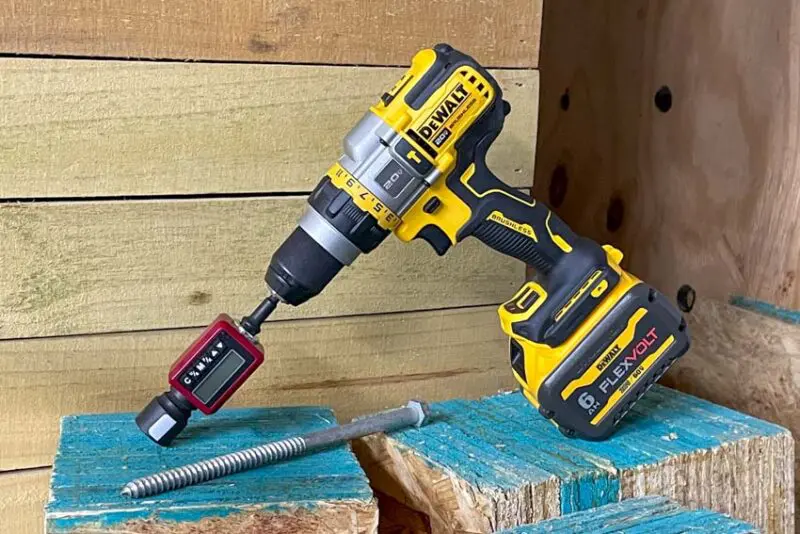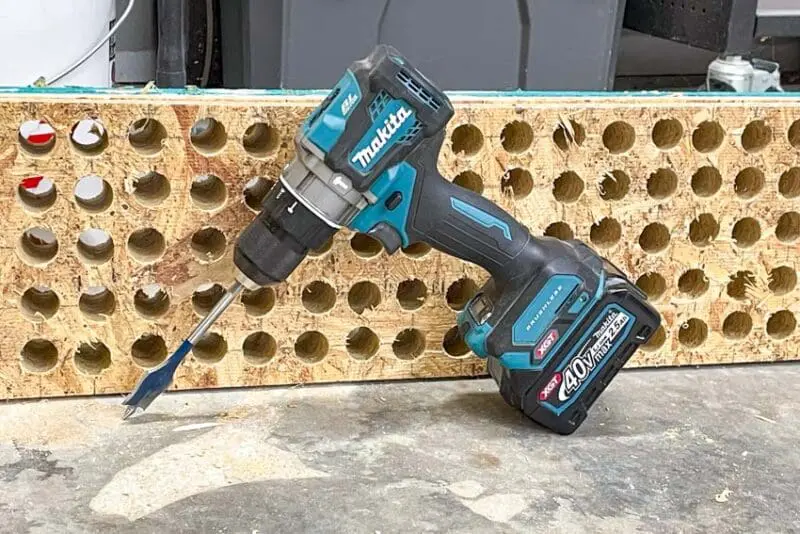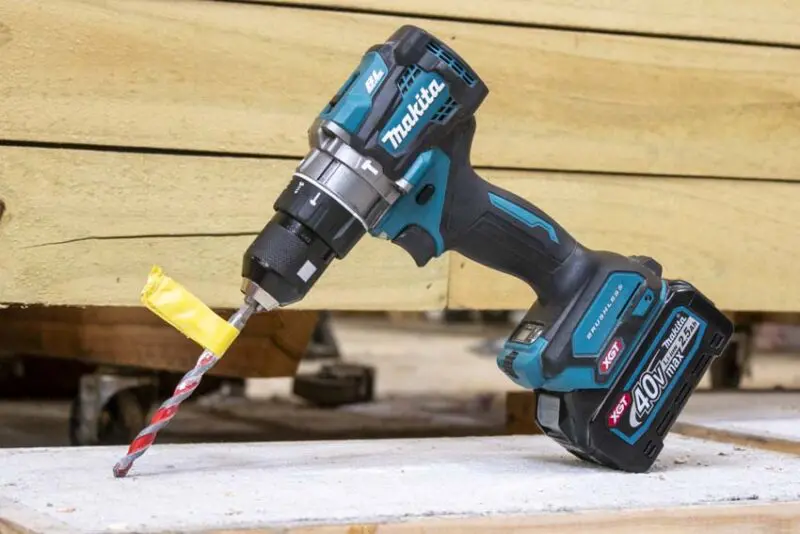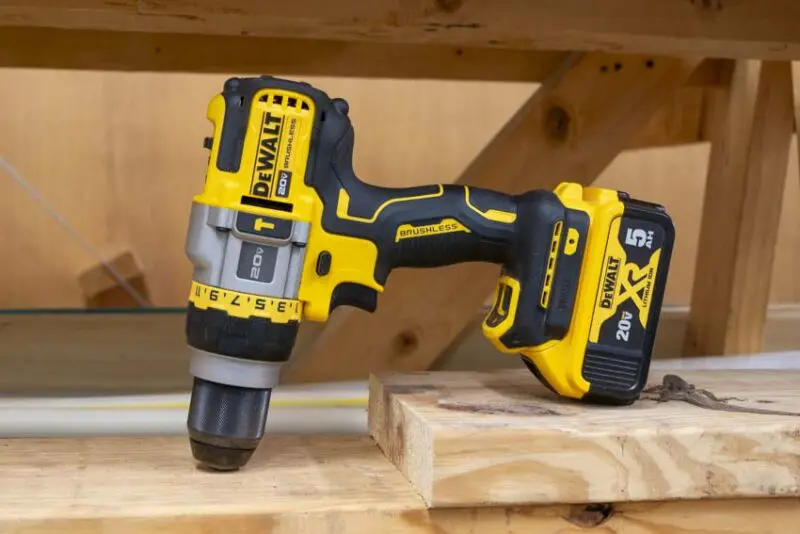This week, we have two of the Big 3 in the game going up against each other with the combined power of King Kong and Godzilla (relatively speaking). Representing the professional class and with features and performance that top the charts, we have a DeWalt vs Makita hammer drill head-to-head review for you!
Check out our DeWalt vs Makita overview for a higher-level comparison!
For DeWalt, we’re looking at the DCD999 20V Max FlexVolt Advantage Hammer Drill. It operates using either a 20V Max battery or FlexVolt battery. Unlike other DeWalt 20V Max tools, when you insert a FlexVolt battery, it steps up to a whole new level. Built on the foundation of the DCD996, it’s a 3-speed design that’s proven itself in the field for years.

On the Makita side, we’re turning to the high-performance 40V max XGT line. The GPH01 may be the first hammer drill on that platform, but Makita has decades of experience building premium drills, including the ones found on its massive 18V LXT system.

We set up four performance tests for these drills to complete. While performance is certainly the biggest consideration for drills at this level, it’s not everything. We’re also breaking down size, weight, features, and price. Once you have all those numbers in front of you, you can decide for yourself whether DeWalt or Milwaukee deserves the win.
Take a look at this year’s top recommendations in our Best Cordless Drill buying guide!
Are We Testing The Best DeWalt Drill?
DeWalt has several drills you might consider “flagship” models. The DCD996 is the foundation. The DCD997 add Tool Connect app-based controls and diagnostics.
The DCD998 steps up yet again with the Power Detect feature that steps up performance when you use an 8.0Ah battery or higher.
The DCD999 tops them all in terms of overall power output, so it’s the natural choice to go against Makita’s GPH01 in a performance-heavy head-to-head review.
DeWalt Vs Makita Hammer Drill Specifications
Before we jump into the performance tests, here’s how these two drills line up on paper.
| DeWalt FlexVolt Advantage DCD999 | Makita 40V max XGT GPH01 | |
| Top Speeds | 450/1300/2000 RPM 500/1500/2250 RPM* | 650/2600 RPM |
| Max Torque | 1219 UWO** | 1250 in-lbs |
| Max Hammer Rate | 38,250 BPM | 39,000 RPM |
| Head Length | 8.4 in | 7.1 in |
| Bare Weight | 3.6 lbs | 3.7 lbs |
| Weight w/Tested Battery | 5.9 lbs (6.0Ah FV battery) 5.0 lbs (5.0Ah battery) | 5.3 lbs (2.5Ah battery)*** |
Take a look at our DeWalt vs Milwaukee Rear-Handle Circular Saw Review!
DeWalt Vs Makita Hammer Drill Test Results
We ran a series of four tests to compare the performance of both hammer drills. We used DeWalt’s 6.0Ah FlexVolt battery and Makita’s 2.5Ah battery. To make sure it’s fair, we recharged the battery before each test.
Soft Torque

To test the soft torque, we used an inline torque meter and drove a thick lag screw as far as we could into stacked OSB subfloor. This gives us an idea of how much torque each drill is able to put into wood fastening, but it’s not perfect.
Modern brushless motors sense the load and shut the motor off before it reaches its full power potential as a protection mechanism. That said, we get an objective, comparable number that’s representative of the soft torque in a demanding wood fastening application.
| DeWalt FlexVolt Advantage DCD999 | Makita 40V max XGT GPH01 | |
| Max Measured Torque | 468 in-lbs | 428 in-lbs |
Spade Bit

For our medium-load test, we used a 1-inch spade bit with a self-feeding tip to drill through 4 inches of stacked and glued 1/2-inch OSB. The result is the average of three tests. Any outlier results were thrown out, and the run repeated.
| DeWalt FlexVolt Advantage DCD999 | Makita 40V max XGT GPH01 | |
| Average Time | 2.7 seconds | 2.6 seconds |
Self-Feed Bit

To get an idea of how these hammer drills perform under a heavy rough-in load, we used a 2 9/16-inch self-feed bit to drill through a 2×4 pine stud. We tried each drill in high speed first, and if it was unable to complete the test, dropped into low gear. The result is the average of three tests. Like before, we eliminated any outlier results and repeated the test.
| DeWalt FlexVolt Advantage DCD999 | Makita 40V max XGT GPH01 | |
| Average Time | 2.3 seconds | 2.1 seconds |
Concrete Bit

The final test was drilling through concrete. Using a 3/8-inch concrete twist bit, we drilled three inches deep in fully cured 4000 PSI concrete. We took an average of three tests to get our results. Again, in the event of any outliers, we threw out the result and repeated the test.
| DeWalt FlexVolt Advantage DCD999 | Makita 40V max XGT GPH01 | |
| Average Time | 2.9 seconds | 4.2 seconds |
What About Using a Standard Battery for DeWalt?

To make our DeWalt vs Milwaukee hammer drill head-to-head review a little more complete, we also gave Milwaukee the advantage of running the same tests with its 6.0Ah High Output battery. You won’t find that battery kitted with this tool, and it adds a bit more weight to the package, but we did see some improvement.
For that matter, we also tested DeWalt with a 5.0Ah battery to see how it performs with that pack as well.
Here’s how it all stacked up:
| DeWalt DCD999 5.0Ah | DeWalt DCD999 6.0Ah FV | Makita 40V max XGT GPH01 | |
| Soft Torque | 380 in-lbs | 468 in-lbs | 428 in-lbs |
| Spade Bit | 3.4 sec | 2.7 sec | 2.6 sec |
| Self-Feed Bit | 3.6 sec | 2.3 sec | 2.1 sec |
| Concrete Bit | 4.2 sec | 2.9 sec | 4.2 sec |
| Weight | 5.0 lbs | 5.9 lbs | 5.3 lbs |
DeWalt Vs Makita Hammer Drill Highlight Features
As the flagship drills for their respective platforms, these are some of the best features available from these two top brands. Here’s a quick breakdown of the major highlights:
DeWalt DCD999
- Brushless motor
- Significant performance boost when using a FlexVolt battery
- 3 speeds
- Higher top speed in hammer drilling mode
- Multiple LED light settings
- Tool Connect Chip ready
Makita GPH01
- Brushless motor
- Kickback control
- 2 speeds
- Electronic clutch (41 low-speed settings, 21 high-speed settings)
DeWalt Vs Makita Hammer Drill Price
The last piece of the puzzle is price. As top-tier tools from premium brands, it’s not a surprise to find that these drills are on the expensive side of what’s available. That doesn’t mean they’re a bad value, though. When you need the best performance available or the most innovative features, these drills can make a real difference in how productive you are, and that can be an excellent value. It’s all about how you work.
One more quick note—you can get Milwaukee’s drill with or without One-Key, so we included both.
| DeWalt FlexVolt Advantage DCD999 | Makita 40V max XGT GPH01 | |
| Bare Tool | $239 | $244 |
| Basic Kit | $329 GPH01 Hammer Drill 1 x 6.0Ah FV Battery | $499 GPH01 Hammer Drill 2 x 2.5Ah Battery |
| 2-Tool Combo | $399 DCD999 Hammer Drill DCF887 Impact Driver 1 x 6.0Ah FV Battery 1 x 2.0Ah Battery | $469 GPH01 Hammer Drill GDT02 Impact Driver 2 x 2.5Ah Battery |



